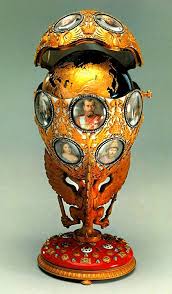The Faberge Eggs
- Alexander Ogilvie-Graham
- Jan 16, 2019
- 3 min read
I was very lucky that my carer John managed to obtain rare tickets to see the Romanov collection of Faberge Eggs at Buckingham Palace. Shakespeare once wrote that "the whole world is a stage" and I believe that Gustav Faberge had this in mind when he was building his beautiful Faberge Eggs, where each one has a hidden message, like a whole new world.
When one looks more at history, once never ceases to learn. For this reason, my favourite non-philosopher or non-military leader is Gustav Faberge. Faberge was born in 1815 in Dresden but moved to Saint Petersburg in Russia where he cemented his stature as a trusted goldsmith. Imagine living in Russia in 1815; Napoleon had just failed to invade and Russians on the whole were still revelling with pride at having fought off the great French Emperor. Thus, Gustav Faberge would have grown up in a proud Russia that would have just defended their homeland from the great French Empire (even though it was actually the cold that had destroyed French forces!) This glory needed to be commemorated and Russian Goldsmiths, like Gustav Faberge, were sought after to supply the Russian court with amazing jewellery and keepsakes which all the nobles wore.
The saying goes that "beauty is in the eye of the beholder", as there are many ways one can view beauty. I believe that the Faberge eggs are extremely beautiful because of their intricate and sometimes complicated form. Conversely, some people may think they are gaudy and ugly. I love the fact that people see art differently, and it forces one to consider what makes good art "good" and bad art "bad". I think that the Faberge eggs inspire people to think all the way from the beginning of civilisation, from mastering fire, through to to the craftsmanship of creating eggs with emeralds and rubies. It is the course of "creation" which is truly beautiful. I think from there we are all inspired to grow into a more enhanced and learned civilisation.
The founder of the Faberge eggs was Gustav's son Peter Carl Faberge, and he became the most famous goldsmith of Imperial Russia. He famously created the eggs for the Easter celebrations and they were commissioned for the Tsar, Alexander III and his son Tsar Nicholas II.
The legacy of the Faberge eggs represent a lost time in Russian history. When the Tsars ruled Russia they were the ultimate boss and they were in charge. The Tsars were able to commission this Goldsmith Faberge as a statement of raw power that they could waste tons of money in building these exquisite objects. The Faberge eggs were mostly used as diplomatic gifts .
Returning to the questions of what constitutes good art or bad art? This is where the unique Faberge eggs come into their own; Faberge did not just make fancy and wonderful eggs that one could not even eat. He was expert goldsmith and it showed in every piece he created.
One of my personal favourites is the Tortoise shell cigarette case which was built in 1890's. I could not even imagine that being casually used by the Russian Imperial family - as a simple cigarette case. One can say what one likes about the Russian Romanov family, but they certainly had excellent taste in finery! I have always loved the colour of shell as it always struck me as a very innocent colour and majestic.
Eggs, what more can I say about Eggs! Eggs can be seen as symbols of creation and of new life, and for this reason the main holiday that is often associated with eggs, is Easter. Thus, the Russian goldsmiths and jewellers of the nineteenth century mastered the art of creating jewels and miniature eggs. Larger eggs, the size of duck eggs were beautifully made with different layers of stones all mashed together to combine one magnificent ultra egg. The Easter eggs which Faberge produced for the Tsars were extremely imaginative; you can clearly see the genius of his work in each individual egg. The first imperial Easter Egg was made in 1911 and it is called the Orange Tree Egg and you can clearly see the beauty of the egg and the skill of its creator.
Overall, I am a huge fan of Faberges and of their wonderful eggs. Imagine if the Tsars had not wasted so much money on Faberge eggs! They may have been able to save their country instead and maybe even have stopped the revolution. Instead they wanted the highest echelon of society to be impressed with what they could waste their money on, in a statement of raw power. In part I agree that it was a waste of money. Then, on the other side I do not agree, and think that perhaps it shows how advanced civilisation has become; that we can create such wonderful objects of beauty.























Comments